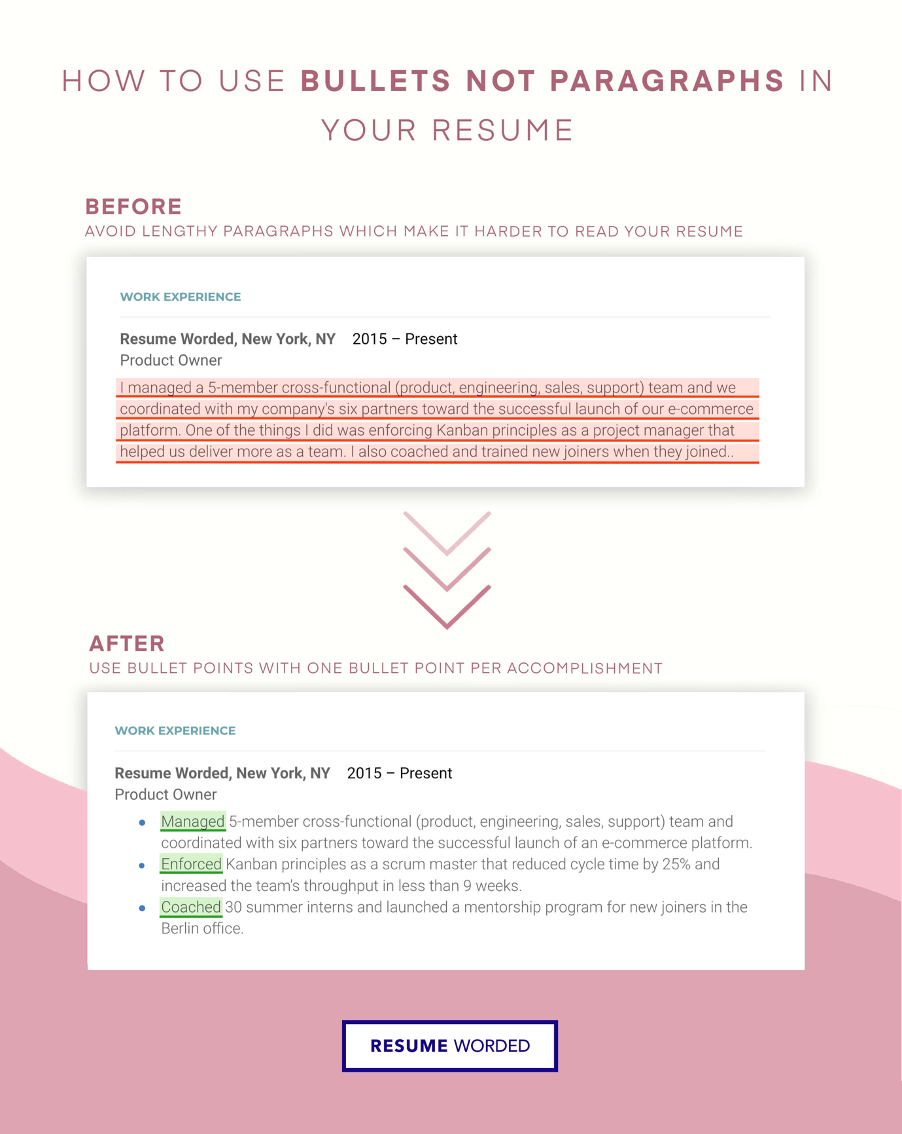One of the age-old questions of resume writing is, should a resume have bullet points or paragraphs?
The verdict is in: Resumes should be written using bullet points.
But is there ever an exception? Is it possible to write a good resume without bullet points? Are there situations where using full sentences on a resume is better? We’ll answer all those questions below, but first, let’s look at why you should use bullet points instead of paragraphs on a resume.
Why you should be using bullet points on a resume
The simple response is “because it’s convention.”
A lot of resume ‘rules’ exist simply because that’s what recruiters expect. Some of these change over time, like not including your mailing address or emailing resumes instead of delivering them in person. Others are in place for a reason and aren’t going anywhere — like using bullets instead of paragraphs on a resume.
Here’s why bullet points are better on a resume than paragraphs:
- Resumes need to be skimmable. Hiring managers have limited time to spend on each resume, so the more information they can get quickly, the better.
- Bullet points are easier to read than full sentences. Short, succinct bullet points are the key to your resume's readability.
- The most important information stands out at a glance instead of being buried in the middle of a paragraph.
- People in general are put off by walls of text (generally, three lines or longer). The longer the text, the less likely it is to be read.
- Bullet points look better on a resume. They preserve white space and keep things neatly organized.
- Hiring managers are used to reading bullet points. If they get to your resume and suddenly find paragraphs of text, it’ll stand out — and not in a good way.
How to turn paragraphs into resume bullet points
If you’ve started writing your resume in paragraphs, you don’t need to throw it out and start over. Here’s how to turn your sentences into resume-friendly bullets:
- Break your paragraph into single sentences or separate accomplishments.
- Take out personal pronouns, like “I” and “we.”
- Start your bullet point with an action verb, like “managed” or “coordinated.”
- Leave out as many extra words as you can, as long as it still makes sense.
- Run your finished resume through an ATS resume scanner for more tips straight from hiring managers.
For example, if you wrote:
I supervised a team of 15 associates in addition to overseeing a staff of 60+ associates while managing daily operations of the store. In a single year, I increased the overall departmental sales by 10% and GROWTHSI designer brand sales by 35%. As manager, I monitored the performance of each team member by conducting a monthly touch base, coaching in the moment, and implementing disciplinary actions in a write up. I also reviewed the operational records and reports monthly to project sales and determine our profitability.
It could become:
- Supervised a team of 15 associates in addition to overseeing a staff of 60+ associates while managing daily operations of the store.
- Increased overall departmental sales by 10% in a single year; and GROWTHSI designer brand by 35%.
- Monitored the performance of each team member by conducting a monthly touch base, coaching in the moment, and implementing disciplinary actions in a write up.
- Reviewed operational records and reports monthly to project sales and determine profitability.
See how much better that looks? By including the same accomplishments in bullet points instead of paragraphs, it becomes easier to read and your accomplishments stand out more.
After you’re done converting your paragraphs to bullet points, upload your resume to the tool below to check if your bullet points are correctly identified. It’ll also identify any mistakes and provide suggestions on how to improve your resume’s bullet points and impact.
Bullet point resume example
Here’s an example of a resume that uses bullet points instead of paragraphs to good effect:
Even the skills section at the end is in bullet points, broken up into different information like techniques, certifications, and technical skills.
You can download this template, including more tips for writing a recruiter-friendly resume using bullet points, at our resume guide.
When you can break the rules (and when you can’t)
There only a couple of places where it’s better to use paragraphs on a resume instead of bullets:
- In your resume summary (here are some great examples)
- In your cover letter
Everywhere else — including your work experience, education, skills and additional sections — you should be using bullet points.
It’s never okay to write a whole resume without using bullet points, for all the reasons listed above.
How are bullet points different from paragraphs?
There’s more difference between paragraphs and bullet points than just putting a bullet at the start. Bullet points aren’t necessarily complete sentences. Here’s how they differ:
- Resume bullet points don’t use personal pronouns. Instead of “I developed …” resume bullets skip straight to “Developed …”
- Resume bullet points leave out unnecessary articles and possessive pronouns, like “the, “a,” and “my”. Instead of “for a Fortune 100 company,” a bullet point might read, “for Fortune 100 company.”
- In general, resume bullet points won’t read like complete, grammatically correct sentences — and that’s okay. Readability and being easily skimmable are more important than impeccable grammar in this case.










